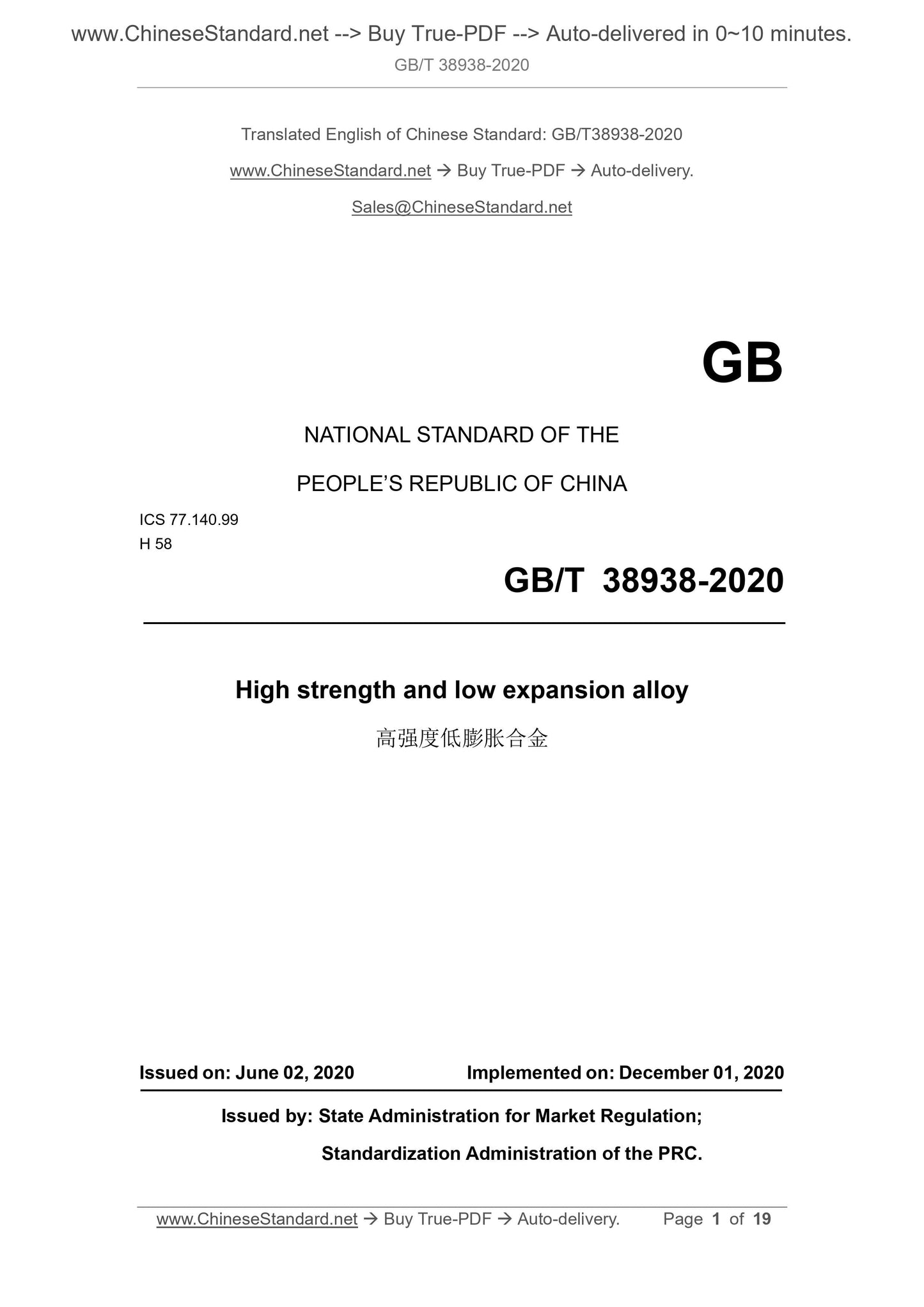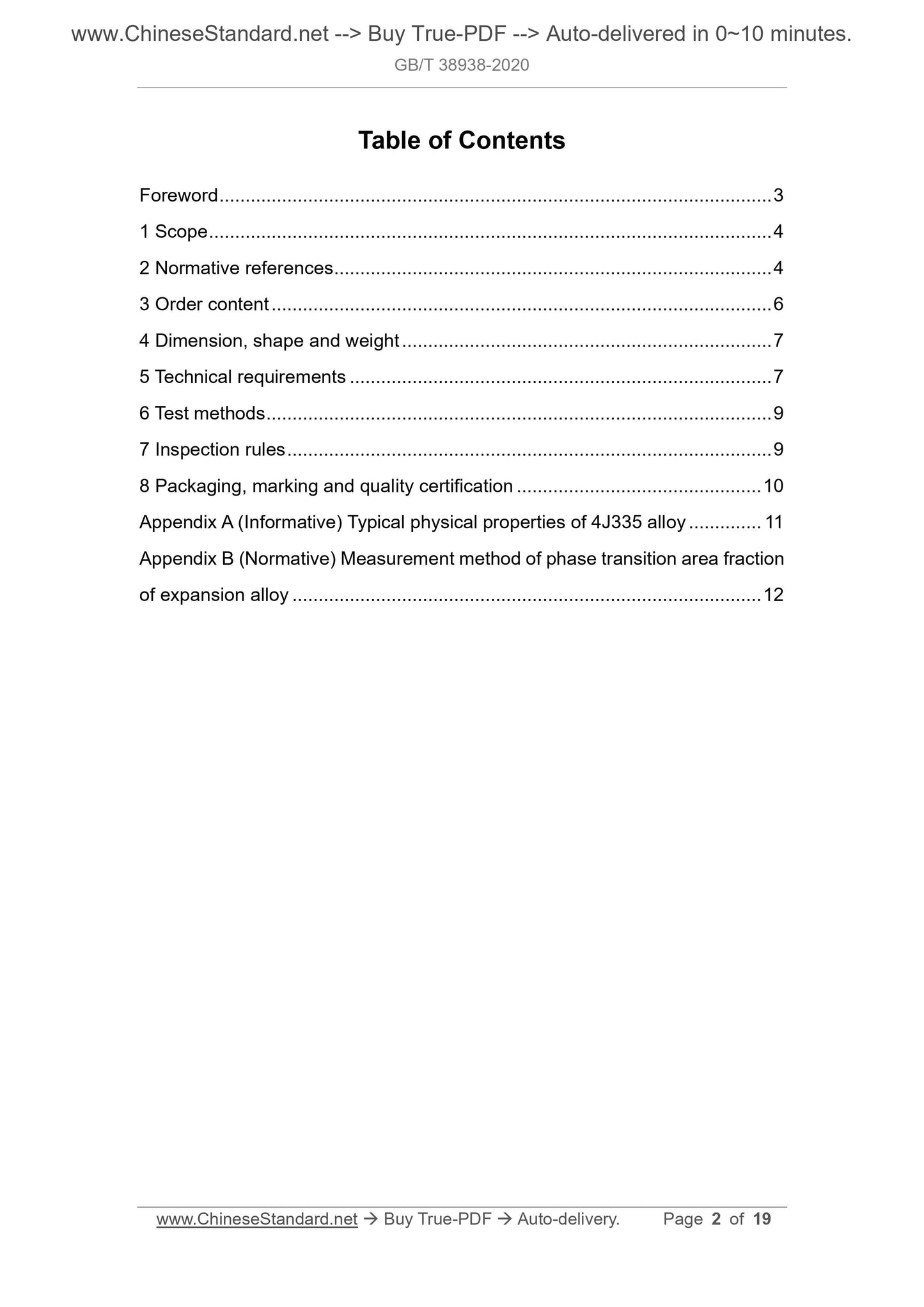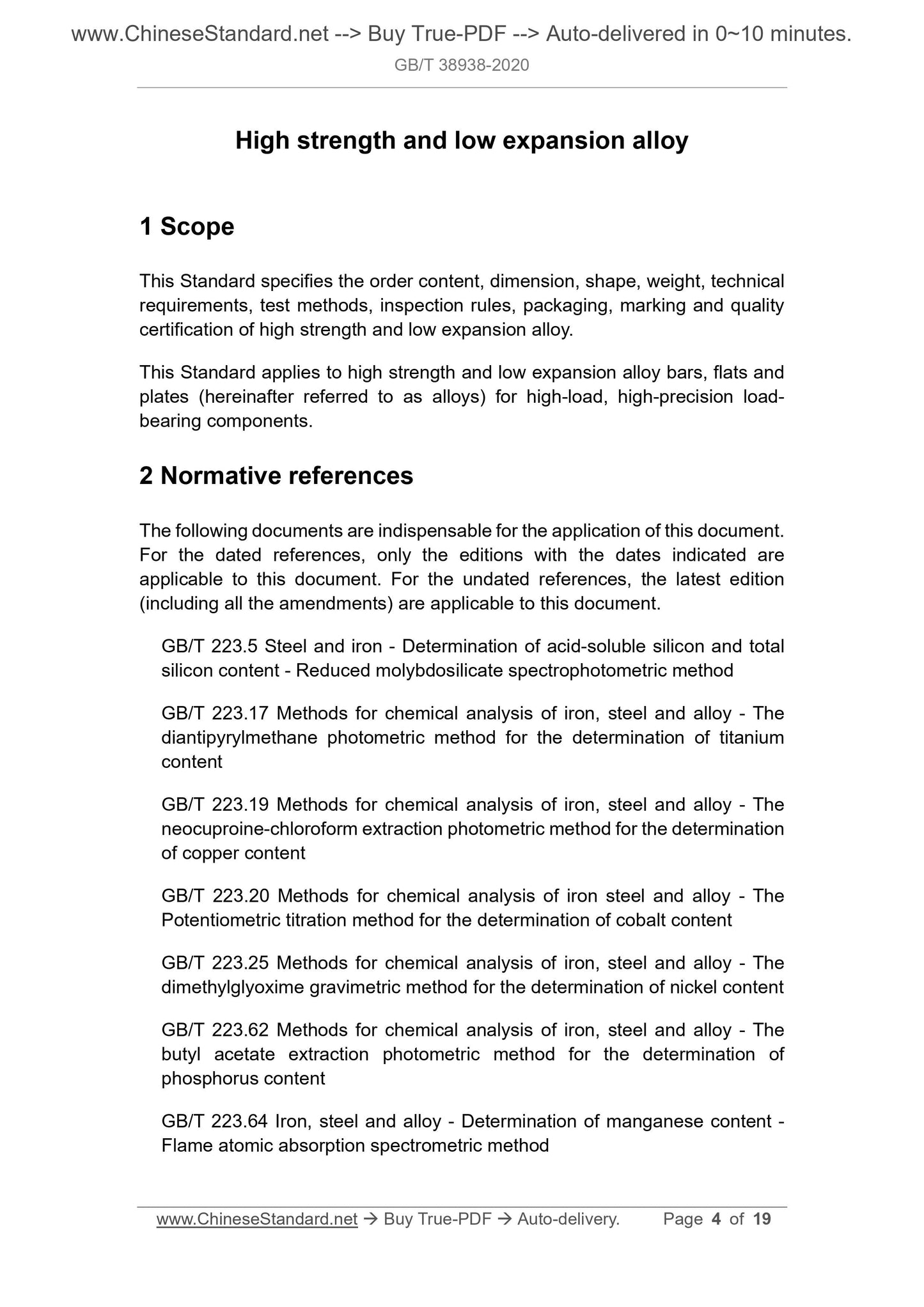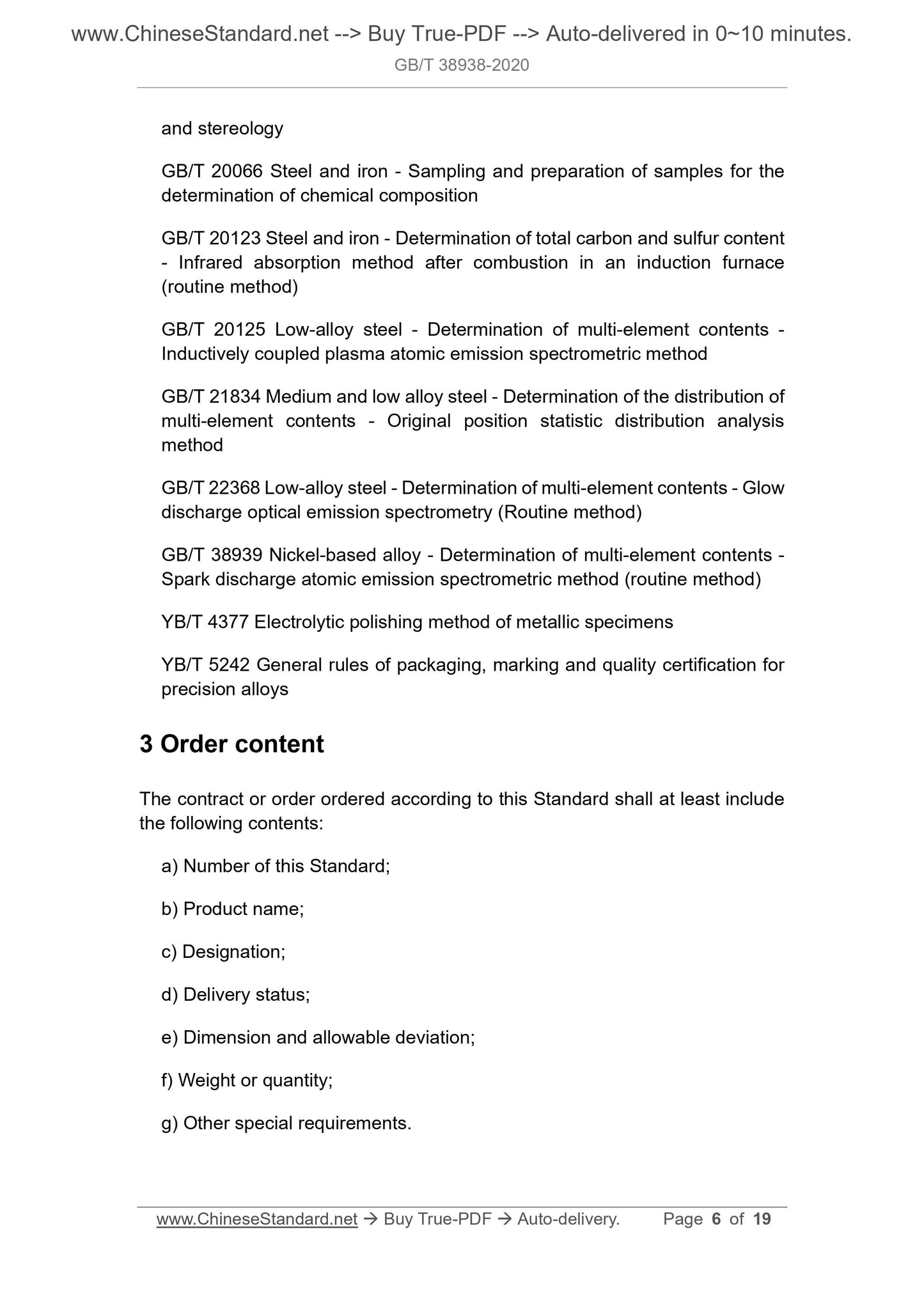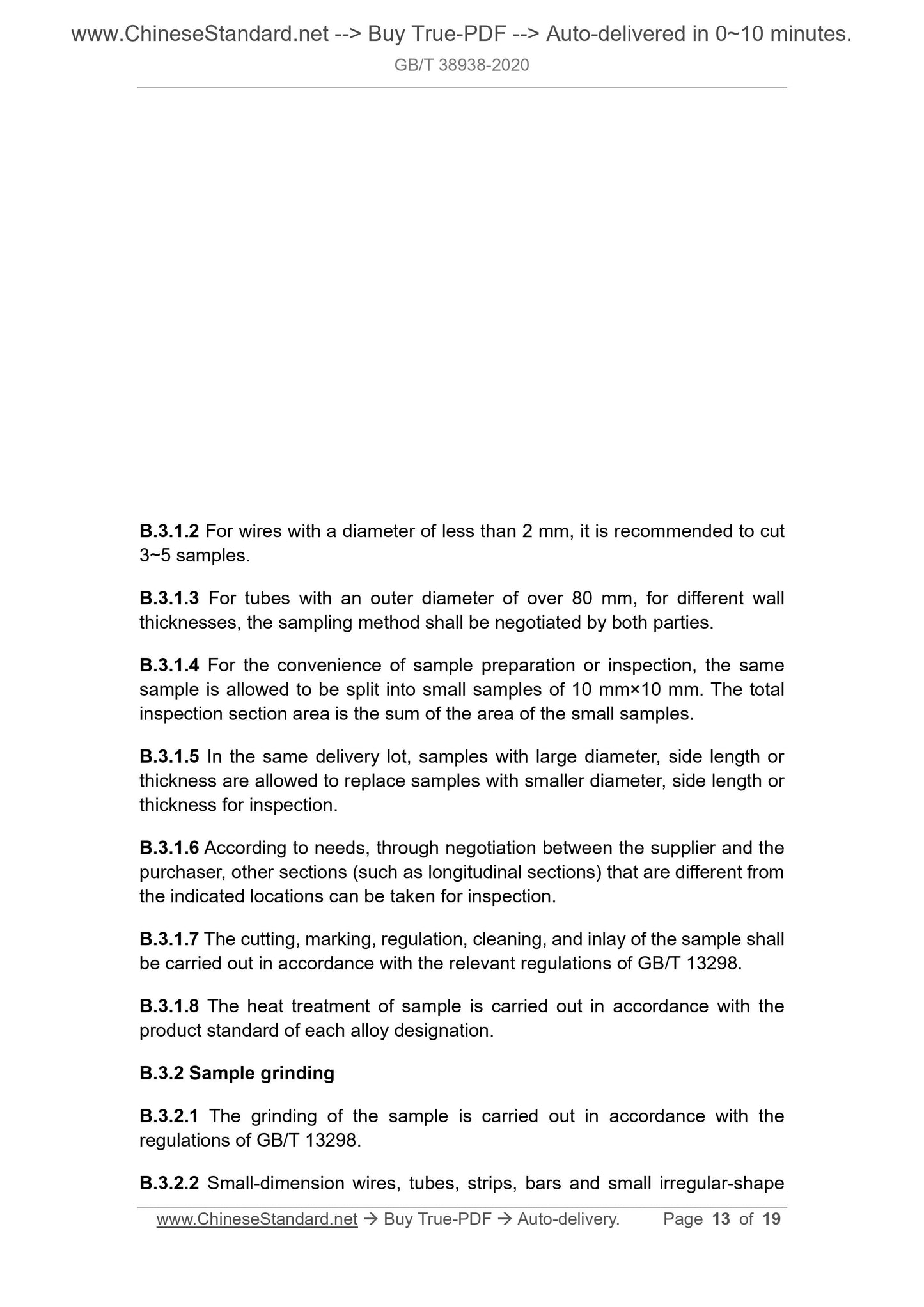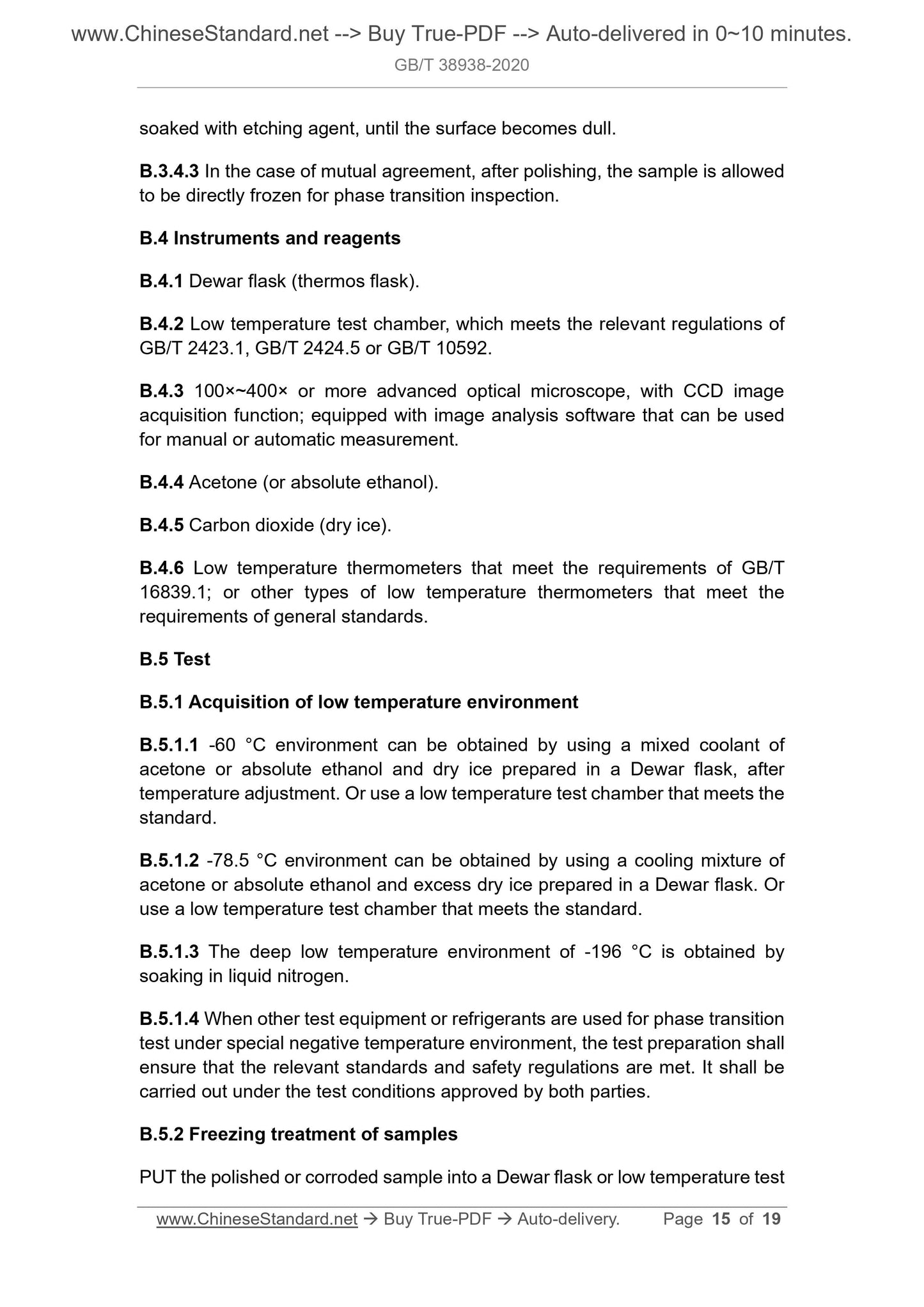PayPal, credit cards. Download editable-PDF & invoice in 1 second!
GB/T 38938-2020 English PDF (GBT38938-2020)
GB/T 38938-2020 English PDF (GBT38938-2020)
Precio habitual
$175.00 USD
Precio habitual
Precio de oferta
$175.00 USD
Precio unitario
/
por
Los gastos de envío se calculan en la pantalla de pago.
No se pudo cargar la disponibilidad de retiro
Delivery: 3 seconds. Download true-PDF + Invoice.
Get QUOTATION in 1-minute: Click GB/T 38938-2020
Historical versions: GB/T 38938-2020
Preview True-PDF (Reload/Scroll if blank)
GB/T 38938-2020: High strength and low expansion alloy
GB/T 38938-2020
GB
NATIONAL STANDARD OF THE
PEOPLE’S REPUBLIC OF CHINA
ICS 77.140.99
H 58
High strength and low expansion alloy
ISSUED ON: JUNE 02, 2020
IMPLEMENTED ON: DECEMBER 01, 2020
Issued by: State Administration for Market Regulation;
Standardization Administration of the PRC.
Table of Contents
Foreword ... 3
1 Scope ... 4
2 Normative references ... 4
3 Order content ... 6
4 Dimension, shape and weight ... 7
5 Technical requirements ... 7
6 Test methods ... 9
7 Inspection rules ... 9
8 Packaging, marking and quality certification ... 10
Appendix A (Informative) Typical physical properties of 4J335 alloy ... 11
Appendix B (Normative) Measurement method of phase transition area fraction
of expansion alloy ... 12
High strength and low expansion alloy
1 Scope
This Standard specifies the order content, dimension, shape, weight, technical
requirements, test methods, inspection rules, packaging, marking and quality
certification of high strength and low expansion alloy.
This Standard applies to high strength and low expansion alloy bars, flats and
plates (hereinafter referred to as alloys) for high-load, high-precision load-
bearing components.
2 Normative references
The following documents are indispensable for the application of this document.
For the dated references, only the editions with the dates indicated are
applicable to this document. For the undated references, the latest edition
(including all the amendments) are applicable to this document.
GB/T 223.5 Steel and iron - Determination of acid-soluble silicon and total
silicon content - Reduced molybdosilicate spectrophotometric method
GB/T 223.17 Methods for chemical analysis of iron, steel and alloy - The
diantipyrylmethane photometric method for the determination of titanium
content
GB/T 223.19 Methods for chemical analysis of iron, steel and alloy - The
neocuproine-chloroform extraction photometric method for the determination
of copper content
GB/T 223.20 Methods for chemical analysis of iron steel and alloy - The
Potentiometric titration method for the determination of cobalt content
GB/T 223.25 Methods for chemical analysis of iron, steel and alloy - The
dimethylglyoxime gravimetric method for the determination of nickel content
GB/T 223.62 Methods for chemical analysis of iron, steel and alloy - The
butyl acetate extraction photometric method for the determination of
phosphorus content
GB/T 223.64 Iron, steel and alloy - Determination of manganese content -
Flame atomic absorption spectrometric method
and stereology
GB/T 20066 Steel and iron - Sampling and preparation of samples for the
determination of chemical composition
GB/T 20123 Steel and iron - Determination of total carbon and sulfur content
- Infrared absorption method after combustion in an induction furnace
(routine method)
GB/T 20125 Low-alloy steel - Determination of multi-element contents -
Inductively coupled plasma atomic emission spectrometric method
GB/T 21834 Medium and low alloy steel - Determination of the distribution of
multi-element contents - Original position statistic distribution analysis
method
GB/T 22368 Low-alloy steel - Determination of multi-element contents - Glow
discharge optical emission spectrometry (Routine method)
GB/T 38939 Nickel-based alloy - Determination of multi-element contents -
Spark discharge atomic emission spectrometric method (routine method)
YB/T 4377 Electrolytic polishing method of metallic specimens
YB/T 5242 General rules of packaging, marking and quality certification for
precision alloys
3 Order content
The contract or order ordered according to this Standard shall at least include
the following contents:
a) Number of this Standard;
b) Product name;
c) Designation;
d) Delivery status;
e) Dimension and allowable deviation;
f) Weight or quantity;
g) Other special requirements.
B.3.1.2 For wires with a diameter of less than 2 mm, it is recommended to cut
3~5 samples.
B.3.1.3 For tubes with an outer diameter of over 80 mm, for different wall
thicknesses, the sampling method shall be negotiated by both parties.
B.3.1.4 For the convenience of sample preparation or inspection, the same
sample is allowed to be split into small samples of 10 mm×10 mm. The total
inspection section area is the sum of the area of the small samples.
B.3.1.5 In the same delivery lot, samples with large diameter, side length or
thickness are allowed to replace samples with smaller diameter, side length or
thickness for inspection.
B.3.1.6 According to needs, through negotiation between the supplier and the
purchaser, other sections (such as longitudinal sections) that are different from
the indicated locations can be taken for inspection.
B.3.1.7 The cutting, marking, regulation, cleaning, and inlay of the sample shall
be carried out in accordance with the relevant regulations of GB/T 13298.
B.3.1.8 The heat treatment of sample is carried out in accordance with the
product standard of each alloy designation.
B.3.2 Sample grinding
B.3.2.1 The grinding of the sample is carried out in accordance with the
regulations of GB/T 13298.
B.3.2.2 Small-dimension wires, tubes, strips, bars and small irregular-shape
soaked with etching agent, until the surface becomes dull.
B.3.4.3 In the case of mutual agreement, after polishing, the sample is allowed
to be directly frozen for phase transition inspection.
B.4 Instruments and reagents
B.4.1 Dewar flask (thermos flask).
B.4.2 Low temperature test chamber, which meets the relevant regulations of
GB/T 2423.1, GB/T 2424.5 or GB/T 10592.
B.4.3 100×~400× or more advanced optical microscope, with CCD image
acquisition function; equipped with image analysis software that can be used
for manual or automatic measurement.
B.4.4 Acetone (or absolute ethanol).
B.4.5 Carbon dioxide (dry ice).
B.4.6 Low temperature thermometers that meet the requirements of GB/T
16839.1; or other types of low temperature thermometers that meet the
requirements of general standards.
B.5 Test
B.5.1 Acquisition of low temperature environment
B.5.1.1 -60 °C environment can be obtained by using a mixed coolant of
acetone or absolute ethanol and dry ice prepared in a Dewar flask, after
temperature adjustment. Or use a low temperature test chamber that meets the
standard.
B.5.1.2 -78.5 °C environment can be obtained by using a cooling mixture of
acetone or absolute ethanol and excess dry ice prepared in a Dewar flask. Or
use a low temperature test chamber that meets the standard.
B.5.1.3 The deep low temperature environment of -196 °C is obtained by
soaking in liquid nitrogen.
B.5.1.4 When other test equipment or refrigerants are used for phase transition
test under special negative temperature environment, the test preparation shall
ensure that the relevant standards and safety regulations are met. It shall be
carried out under the test conditions approved by both parties.
B.5.2 Freezing treatment of samples
PUT the polished or corroded sample into a Dewar flask or low temperature test
Get QUOTATION in 1-minute: Click GB/T 38938-2020
Historical versions: GB/T 38938-2020
Preview True-PDF (Reload/Scroll if blank)
GB/T 38938-2020: High strength and low expansion alloy
GB/T 38938-2020
GB
NATIONAL STANDARD OF THE
PEOPLE’S REPUBLIC OF CHINA
ICS 77.140.99
H 58
High strength and low expansion alloy
ISSUED ON: JUNE 02, 2020
IMPLEMENTED ON: DECEMBER 01, 2020
Issued by: State Administration for Market Regulation;
Standardization Administration of the PRC.
Table of Contents
Foreword ... 3
1 Scope ... 4
2 Normative references ... 4
3 Order content ... 6
4 Dimension, shape and weight ... 7
5 Technical requirements ... 7
6 Test methods ... 9
7 Inspection rules ... 9
8 Packaging, marking and quality certification ... 10
Appendix A (Informative) Typical physical properties of 4J335 alloy ... 11
Appendix B (Normative) Measurement method of phase transition area fraction
of expansion alloy ... 12
High strength and low expansion alloy
1 Scope
This Standard specifies the order content, dimension, shape, weight, technical
requirements, test methods, inspection rules, packaging, marking and quality
certification of high strength and low expansion alloy.
This Standard applies to high strength and low expansion alloy bars, flats and
plates (hereinafter referred to as alloys) for high-load, high-precision load-
bearing components.
2 Normative references
The following documents are indispensable for the application of this document.
For the dated references, only the editions with the dates indicated are
applicable to this document. For the undated references, the latest edition
(including all the amendments) are applicable to this document.
GB/T 223.5 Steel and iron - Determination of acid-soluble silicon and total
silicon content - Reduced molybdosilicate spectrophotometric method
GB/T 223.17 Methods for chemical analysis of iron, steel and alloy - The
diantipyrylmethane photometric method for the determination of titanium
content
GB/T 223.19 Methods for chemical analysis of iron, steel and alloy - The
neocuproine-chloroform extraction photometric method for the determination
of copper content
GB/T 223.20 Methods for chemical analysis of iron steel and alloy - The
Potentiometric titration method for the determination of cobalt content
GB/T 223.25 Methods for chemical analysis of iron, steel and alloy - The
dimethylglyoxime gravimetric method for the determination of nickel content
GB/T 223.62 Methods for chemical analysis of iron, steel and alloy - The
butyl acetate extraction photometric method for the determination of
phosphorus content
GB/T 223.64 Iron, steel and alloy - Determination of manganese content -
Flame atomic absorption spectrometric method
and stereology
GB/T 20066 Steel and iron - Sampling and preparation of samples for the
determination of chemical composition
GB/T 20123 Steel and iron - Determination of total carbon and sulfur content
- Infrared absorption method after combustion in an induction furnace
(routine method)
GB/T 20125 Low-alloy steel - Determination of multi-element contents -
Inductively coupled plasma atomic emission spectrometric method
GB/T 21834 Medium and low alloy steel - Determination of the distribution of
multi-element contents - Original position statistic distribution analysis
method
GB/T 22368 Low-alloy steel - Determination of multi-element contents - Glow
discharge optical emission spectrometry (Routine method)
GB/T 38939 Nickel-based alloy - Determination of multi-element contents -
Spark discharge atomic emission spectrometric method (routine method)
YB/T 4377 Electrolytic polishing method of metallic specimens
YB/T 5242 General rules of packaging, marking and quality certification for
precision alloys
3 Order content
The contract or order ordered according to this Standard shall at least include
the following contents:
a) Number of this Standard;
b) Product name;
c) Designation;
d) Delivery status;
e) Dimension and allowable deviation;
f) Weight or quantity;
g) Other special requirements.
B.3.1.2 For wires with a diameter of less than 2 mm, it is recommended to cut
3~5 samples.
B.3.1.3 For tubes with an outer diameter of over 80 mm, for different wall
thicknesses, the sampling method shall be negotiated by both parties.
B.3.1.4 For the convenience of sample preparation or inspection, the same
sample is allowed to be split into small samples of 10 mm×10 mm. The total
inspection section area is the sum of the area of the small samples.
B.3.1.5 In the same delivery lot, samples with large diameter, side length or
thickness are allowed to replace samples with smaller diameter, side length or
thickness for inspection.
B.3.1.6 According to needs, through negotiation between the supplier and the
purchaser, other sections (such as longitudinal sections) that are different from
the indicated locations can be taken for inspection.
B.3.1.7 The cutting, marking, regulation, cleaning, and inlay of the sample shall
be carried out in accordance with the relevant regulations of GB/T 13298.
B.3.1.8 The heat treatment of sample is carried out in accordance with the
product standard of each alloy designation.
B.3.2 Sample grinding
B.3.2.1 The grinding of the sample is carried out in accordance with the
regulations of GB/T 13298.
B.3.2.2 Small-dimension wires, tubes, strips, bars and small irregular-shape
soaked with etching agent, until the surface becomes dull.
B.3.4.3 In the case of mutual agreement, after polishing, the sample is allowed
to be directly frozen for phase transition inspection.
B.4 Instruments and reagents
B.4.1 Dewar flask (thermos flask).
B.4.2 Low temperature test chamber, which meets the relevant regulations of
GB/T 2423.1, GB/T 2424.5 or GB/T 10592.
B.4.3 100×~400× or more advanced optical microscope, with CCD image
acquisition function; equipped with image analysis software that can be used
for manual or automatic measurement.
B.4.4 Acetone (or absolute ethanol).
B.4.5 Carbon dioxide (dry ice).
B.4.6 Low temperature thermometers that meet the requirements of GB/T
16839.1; or other types of low temperature thermometers that meet the
requirements of general standards.
B.5 Test
B.5.1 Acquisition of low temperature environment
B.5.1.1 -60 °C environment can be obtained by using a mixed coolant of
acetone or absolute ethanol and dry ice prepared in a Dewar flask, after
temperature adjustment. Or use a low temperature test chamber that meets the
standard.
B.5.1.2 -78.5 °C environment can be obtained by using a cooling mixture of
acetone or absolute ethanol and excess dry ice prepared in a Dewar flask. Or
use a low temperature test chamber that meets the standard.
B.5.1.3 The deep low temperature environment of -196 °C is obtained by
soaking in liquid nitrogen.
B.5.1.4 When other test equipment or refrigerants are used for phase transition
test under special negative temperature environment, the test preparation shall
ensure that the relevant standards and safety regulations are met. It shall be
carried out under the test conditions approved by both parties.
B.5.2 Freezing treatment of samples
PUT the polished or corroded sample into a Dewar flask or low temperature test
Share
